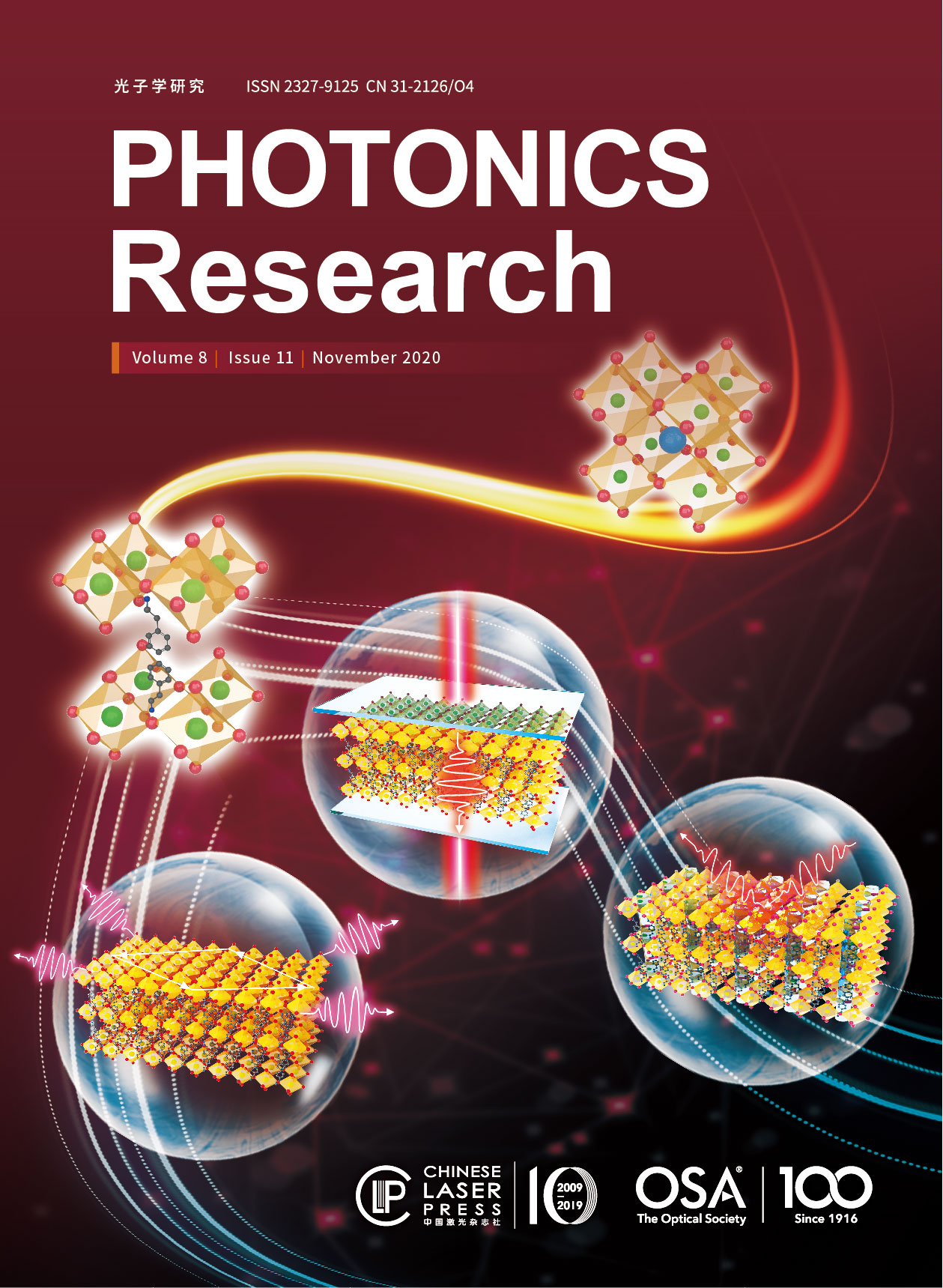Halide perovskites, such as methylammonium lead halide perovskites (
- Publication Date: Oct. 30, 2020
- Vol. 8, Issue 11, A56 (2020)
Two-dimensional (2D) perovskites are hybrid layered materials in which the inorganic lattice of an octahedron is sandwiched by organic layers. They behave as a quantum-well structure exhibiting large exciton binding energy and high emission efficiency, which is excellent for photonic applications. Hence, the cavity modulation and cavity devices of 2D perovskites are widely investigated. In this review, we summarize the rich photophysics, synthetic methods of different cavity structures, and the cavity-based applications of 2D perovskites. We highlight the strong exciton–photon coupling and photonic lasing obtained in different cavity structures. In addition, functional optoelectronic devices using cavity structures of 2D perovskites are also reviewed.
.- Publication Date: Oct. 30, 2020
- Vol. 8, Issue 11, A72 (2020)
Manipulating radiation is important for a variety of optoelectronic applications, such as on-chip lasers, energy-efficient grating couplers, and antennas for light detection and ranging. Although designing and optimizing those optoelectronic devices are usually believed to be an engineering-oriented task, recent research reveals that the principles underlying radiation manipulation are closely connected to the concept of topology—the study of properties that are invariant under continuous deformations. In this review, we summarize a series of advances of the physics, phenomena, and applications related to radiation manipulation, in which topological concepts were adopted. Radiation could carry energy escaping from the system, breaking the energy conservation. The non-Hermiticity of such systems brings quite different physical consequences when comparing with the Hermitian counterparts and, hence, also results in the emergence of many interesting and extraordinary phenomena. In particular, it is found that the perfect trapping of light can still be realized in such non-Hermitian systems because of the photonic realization of bound states in the continuum. The fundamental nature of bound states in the continuum has been identified to be topological: they are essentially topological defects of the polarization vector field in momentum space, depicted by a kind of topological invariant named topological charges. Therefore, manipulation of radiation channels can be realized by controlling the topological charge evolution in momentum space. It is also demonstrated that the photonic states accompanied with different topological charges generate vortex beams with unique far-field radiation patterns, and ultra-fast switching of such vortex beams is demonstrated according to this principle. The progresses of topological photonics upon light radiation show that the topology is not just mathematical convenience for depicting photonic systems, but has brought realistic consequences in manipulating light and will boost the applications of photonics and optoelectronics in many aspects.
.- Publication Date: Oct. 21, 2020
- Vol. 8, Issue 11, B25 (2020)
The realization of robust coherent energy transfer with a long range from a donor to an acceptor has many important applications in the field of quantum optics. However, it is hard to be realized using conventional schemes. Here, we demonstrate theoretically that robust energy transfer can be achieved using a photonic crystal platform, which includes the topologically protected edge state and zero-dimensional topological corner cavities. When the donor and the acceptor are put into a pair of separated topological cavities, the energy transfer between them can be fulfilled with the assistance of the topologically protected interface state. Such an energy transfer is robust against various kinds of defects, and can also occur over very long distances, which is very beneficial for biological detections, sensors, quantum information science, and so on.
.- Publication Date: Oct. 30, 2020
- Vol. 8, Issue 11, B39 (2020)
- Publication Date: Oct. 22, 2020
- Vol. 8, Issue 11, 1703 (2020)
- Publication Date: Oct. 30, 2020
- Vol. 8, Issue 11, 1800 (2020)
- Publication Date: Oct. 22, 2020
- Vol. 8, Issue 11, 1757 (2020)
- Publication Date: Oct. 30, 2020
- Vol. 8, Issue 11, 1808 (2020)
- Publication Date: Oct. 30, 2020
- Vol. 8, Issue 11, 1792 (2020)
- Publication Date: Oct. 22, 2020
- Vol. 8, Issue 11, 1749 (2020)
- Publication Date: Oct. 22, 2020
- Vol. 8, Issue 11, 1725 (2020)
- Publication Date: Oct. 22, 2020
- Vol. 8, Issue 11, 1734 (2020)
- Publication Date: Oct. 12, 2020
- Vol. 8, Issue 11, 1687 (2020)
- Publication Date: Oct. 12, 2020
- Vol. 8, Issue 11, 1676 (2020)
- Publication Date: Oct. 09, 2020
- Vol. 8, Issue 11, 1671 (2020)
- Publication Date: Oct. 30, 2020
- Vol. 8, Issue 11, 1786 (2020)
- Publication Date: Oct. 14, 2020
- Vol. 8, Issue 11, 1697 (2020)
- Publication Date: Oct. 09, 2020
- Vol. 8, Issue 11, 1662 (2020)
- Publication Date: Oct. 26, 2020
- Vol. 8, Issue 11, 1776 (2020)
- Publication Date: Oct. 22, 2020
- Vol. 8, Issue 11, 1742 (2020)
- Publication Date: Oct. 26, 2020
- Vol. 8, Issue 11, 1783 (2020)
About the Cover
The construction of two-dimensional perovskite based optical cavities, including self-assembled single crystal cavity, vertical Fabry–Pérot cavity and photonic crystal structure.
















